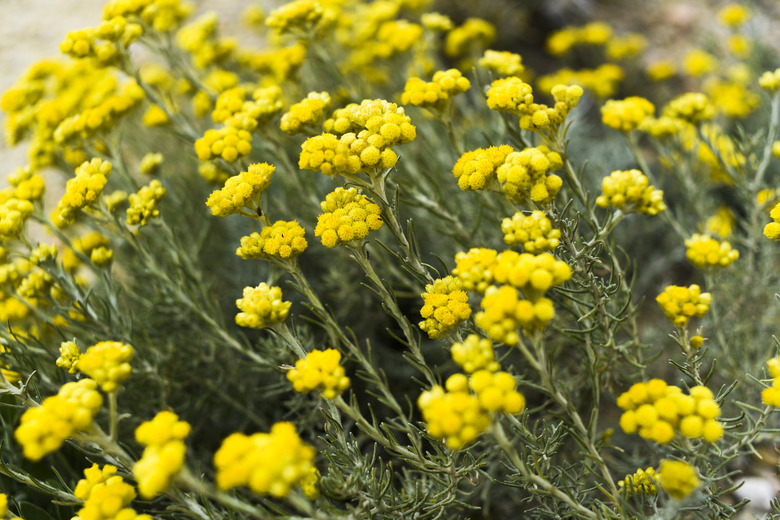How To Kill Weeds In Sand
We may receive a commission on purchases made from links.
Weeds are unwanted plants growing in the wrong place at the wrong time. You can prevent or kill weeds in sand and other soil types by practicing cultural controls, removing them manually, solarizing the soil or applying weed killers. Sand and sandy soils may require special consideration if the ground water is high or if desirable plants and trees are growing near the weeds.
Before You Begin
Before You Begin
No matter which method you choose, put on protective gear before you begin removing or killing weeds. Safety goggles, gloves, long sleeves, long pants, closed-toe shoes and a dust mask protect your eyes, skin and lungs from flying debris, scratchy weeds and soil bacteria.
If you're going to work around or trim back desirable plants before or after eliminating the weeds, also take time to sterilize your digging and cutting tools by dipping the blades or wiping them in rubbing alcohol.
Manual Methods of Removing Weeds
Manual Methods of Removing Weeds
Removing weeds manually is relatively easy in the soft, loose texture of sand and sandy soils. A hoe, stirrup hoe or rake allow you to quickly uproot weeds and remove them from the soil. Deep-rooted weeds, such as dandelions, may require a sharp spade or weed-pulling tool to loosen the sand or soil around the long root before you pull it up.
Cultural Control of Weeds
Cultural Control of Weeds
Controlling weeds, whether in sand or other soil types, is easier if you practice proactive measures. Cover the sand or soil around your landscape plants and trees with a thick layer of organic mulch to discourage weed germination. Mow lawns at the recommended height and water and fertilize to encourage the grass to crowd out weeds. Use water-saving methods in the landscape, such as a drip-irrigation system, to water only the plants you want to keep and discourage weed growth.
Solarization and Weeds in Sand
Solarization and Weeds in Sand
Solarizing large areas of sand or garden beds may be easier than manually removing weeds. Wait until the hot, sunny days of summer and then scalp the area with a lawn mower or loosen the sand or soil. Wet the ground thoroughly. Cover it with clear plastic sheeting and seal the perimeter by weighing down the plastic with rocks, boards or bricks.
Monitor the area to ensure that the plastic remains intact. Patch holes with packing tape or duct tape if necessary. Leave the plastic over the sand or soil for up to eight weeks. The weed seeds germinate in the hot, moist environment and then die in the heat generated by the sun beating down on the plastic.
So-Called Natural Weed Controls
So-Called Natural Weed Controls
Often touted as "natural," using vinegar, salt and dishwashing liquid or other combinations of common household items can adversely affect sand, soil and surrounding plants. Twenty percent horticultural vinegar is an acid and should be treated with extreme caution. Even 5 percent household vinegar can damage your eyes and skin.
The salt may kill the weeds, but it also damages any plants in the vicinity that are sensitive to salty soils. In addition, many beach weeds that thrive on sand are also resistant to salt, so the solution will not affect the plants' roots. Dishwashing soap is not formulated the same as insecticidal soaps and may do more harm than good.
While these "natural" concoctions may be somewhat effective on some shallow-rooted weeds and grasses, the effect is only temporary on deep-rooted weeds. Basically, it kills the foliage, but the weed will grow back from the roots.
Chemical Controls and Weeds
Chemical Controls and Weeds
Applying a commercially prepared chemical control, such as an herbicide, is sometimes necessary when other methods are not working with stubborn weeds. When applying any herbicidal product to sand and sandy soils, use caution if the water table is high. Herbicides, such as atrazine and imazaquin products, travel through the soil and can reach and contaminate the groundwater.
Preemergent herbicides kill the weeds before they're able to grow and become established in sand or soil. They don't stop germination but interfere with the growth process of newly germinated seedlings. They are not effective on actively growing weeds. One flaw in preemergent products is that they can also interfere with the growth of grass, vegetable and flower seedlings. Wait at least four weeks after applying it to the sand or soil before sowing seeds.
Post-emergent herbicides work on actively growing weeds. Some target broadleaf or grassy weeds, while others, like glyphosate products, are nonspecific and will kill both weeds and desirable plants indiscriminately. Avoid using weed killers on breezy days, as the drifting herbicide may endanger the rest of the landscape.
